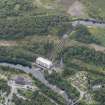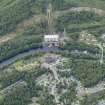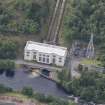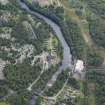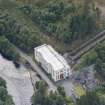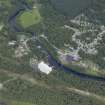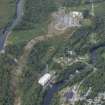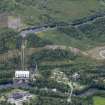Pricing Change
New pricing for orders of material from this site will come into place shortly. Charges for supply of digital images, digitisation on demand, prints and licensing will be altered.
Upcoming Maintenance
Please be advised that this website will undergo scheduled maintenance on the following dates:
Thursday, 9 January: 11:00 AM - 3:00 PM
Thursday, 23 January: 11:00 AM - 3:00 PM
Thursday, 30 January: 11:00 AM - 3:00 PM
During these times, some functionality such as image purchasing may be temporarily unavailable. We apologise for any inconvenience this may cause.
Tummel Bridge Hydroelectric Electricity Generating Station
Hydroelectric Power Station (Modern)
Site Name Tummel Bridge Hydroelectric Electricity Generating Station
Classification Hydroelectric Power Station (Modern)
Alternative Name(s) Tummel Bridge Power Station; Grampian Hydroelectric Scheme
Canmore ID 165332
Site Number NN75NE 71
NGR NN 7635 5900
Datum OSGB36 - NGR
Permalink http://canmore.org.uk/site/165332
First 100 images shown. See the Collections panel (below) for a link to all digital images.
- Council Perth And Kinross
- Parish Dull
- Former Region Tayside
- Former District Perth And Kinross
- Former County Perthshire
NN75NE 71.00 7635 5900
NN75NE 71.01 NN 7626 5881 to NN 7635 5900 surge tower and pipelines
NN75NE 71.02 NN 7629 5901 transformer station
For supplying aqueduct (lade), see NN75NW 28.
Tummel Power Station [NAT]
OS 1:10,000 map, 1992.
Power Station, Tummel Bridge, 1933. Muscular inter-war classicism, painted bright white. Built for the Scottish Power Company as part of the Tummel Valley hydro-electric scheme, the station, fed by a catchment area of 381 square miles, gathered into Loch Rannoch and a smaller reservoir at Dunalastair, and delivered from an aqueduct. Two generating sets, producing a total of 34mW, are unusual in that each turbine has two horizontal runnes and spiral casings.
N Haynes 2000.
Note (2010)
This powerhouse utilises water from the Dunalasatir dam (see separate record) which is brought by aqueduct and pipeline to the station some 3 miles from the dam. The powerhouse contains the original two Francis turbines which are in a vertical orientation and are undershot. The powerhouse also contains the original control and monitoring systems. This is a highly significant example of the use of Hydro for large scale public supply, with the capacity for baseload generation. The classical design of the exterior of the building makes the powerhouse a prominent feature of the landscape, with original features such as control panels and turbines retained to the interior. Tummel Bridge is one of a pair of powerhouses in the scheme of similar design (see Rannoch Station). The Rannoch / Tummel scheme is distinct from the Falls of Clyde scheme (which predates it) because it uses different technology as a reservoir scheme instead of a run-of-the-river development. P L Payne,1988; E Wood, 2002; J Miller, 2002.
http://canmore.rcahms.gov.uk/en/site/165332/details/tummel+power+station/
Standing Building Recording (4 May 2021 - 5 May 2021)
NN 7635 5900 An enhanced historic building survey was carried out of Tummel Power Station, Tummel Bridge, on 4–5 May 2021, prior to the alteration of the existing structure including the replacement of historic plant and machinery and other internal alterations.
Tummel Power Station is an example of inter war classicism design, with the imposing design dominating the surrounding area. Built during the early 1930s it epitomises inter war modernisation and it is a highly significant example of the use of hydro for large-scale public supply, with the capacity for baseload generation. The retention of much of the original internal plant and machinery adds to its significance and stands as a testament to the quality of its design.
Archive: NRHE (intended) Funder: SSE Renewables Limited
Robert Usher – AOC Archaeology Group
(Source: DES Vol 22)
Information from OASIS Id: aocarcha1-425152 (R. Usher) 2021
Note (25 October 2023)
The Tummel-Garry hydroelectric power Scheme
The second of the Hydro Board's schemes was an extension of the Grampian Electricity Company's scheme. The Clunie Dam was constructed at the east end of Loch Tummel, increasing its size. A tunnel connects to Clunie power station below the Falls of Tummel. A dam was built at the east end of Loch Errochty whose water was fed by a tunnel and pipeline to a power station at the head of Loch Tummel. Finally, the River Tummel was impounded at Pitlochry forming Loch Faskally. The power station here is built into the dam and incorporates a fish ladder to allow salmon to pass. Loch Faskally forms a balancing reservoir for fluctuations in flow due to the Clunie power station's operations.
The scheme produces a total of 150,000 kW. Work started in 1946 and experienced similar problems to Loch Sloy due to shortages of labour and material, being completed in 1951.
This account relates to the Scottish Hydro collection of photographic images held at HES, Edinburgh. Compiled by a volunteer, Mr George Walker in 2005.
Information from HES (Miriam McDonald), 25 October 2023.
Photographic Survey
A photographic survey was carried out by HES, Heritage Directorate, Survey and Recording Section, Architecture and Industry in advance of turbine upgrade and other engineering work.
Information from M McDonald, HES Survey and Recording Section, Heritage Directorate, August 2019.











































































































